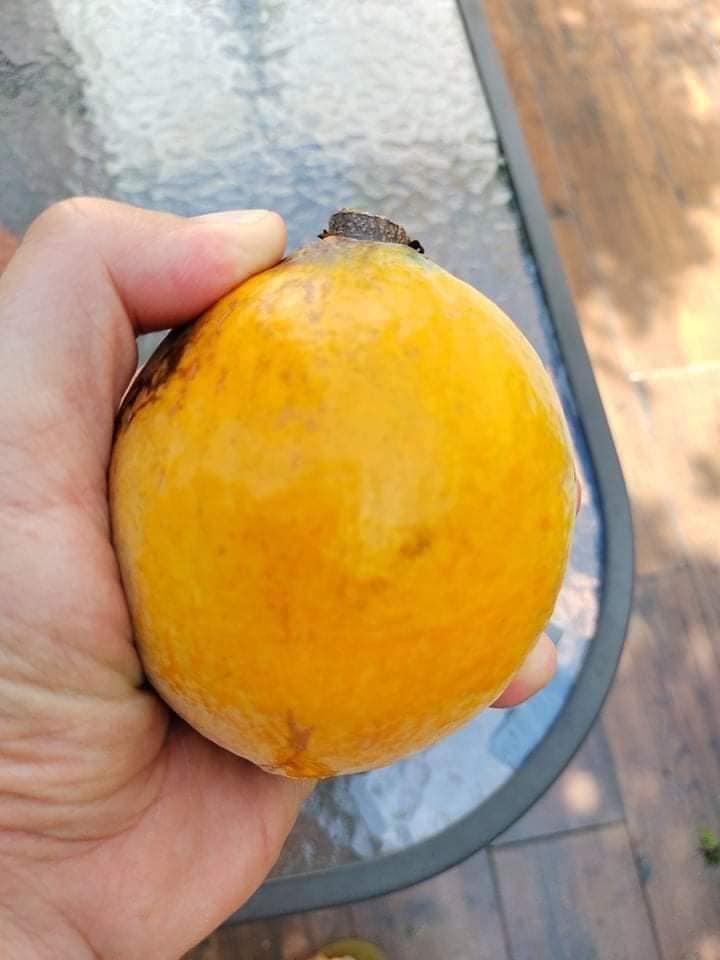Love it? Add to your wishlist
Your favorites, all in one place. Shop quickly and easily with the wishlist feature!
[message]
[title]
[message]



Veliyath Gardens
Couldn't load pickup availability
Found threading through the shaded canopies of tropical Asia, the Gogo Fruit Plant (Salacia macrophylla) is more than a botanical curiosity—it's a gift of nature that has sustained traditional communities for centuries. Native to regions like India, Myanmar, and Indonesia, and spread across countries like Thailand, Cambodia, and Malaysia, this scrambling shrub or occasional climber weaves its presence through dense forest edges and understories, quietly offering its powerful medicinal and nutritional gifts.
What sets the Gogo plant apart is not only its exotic, citrus-like drupe but the diverse cultural and therapeutic roles it plays. With time, it has evolved from a forest herb to a rare treasure for garden lovers seeking both beauty and benefit.
Growth Habit: Woody shrub with a climbing or scrambling nature. Can be trained as a structured climber in gardens.
Fruit Description: The fruit is a subglobose drupe, measuring 5–6 cm in diameter and occasionally reaching up to 8 cm. It resembles a small orange in structure but surprises with a much more refined flavor profile.
Flowering and Fruiting: Begins to bear fruit in 2 to 3 years from planting.
Maintenance Needs: Moderate care is sufficient—occasional pruning, adequate sunlight, and protection from frost ensure robust growth.
Preferred Climate: Thrives in humid tropical or semi-tropical environments, making it ideal for fruit lovers in suitable zones.
Described by traditional gatherers and early botanists alike, the Gogo fruit has a flavor that defies expectation. While its form may resemble citrus, its soft, caramel-sweet flesh carries unique vanilla-like notes with an aromatic finish, making it a delicacy for those who try it. Its taste is rare, exotic, and refined—a perfect fruit to savor fresh, or use to infuse herbal drinks and desserts.
The Gogo plant is deeply respected across several cultures for its curative powers. From folk healers to modern herbalists, its medicinal spectrum is vast and versatile.
Blood Sugar Control: Traditionally used in Southeast Asia—especially by the Dai people of Yunnan—as a natural remedy for Diabetes mellitus. Modern animal studies support its hypoglycemic and lipid-lowering effects.
Joint and Muscle Health: Widely used in local medicine for arthritis, rheumatism, sprains, and muscle aches.
Skin and Hair Treatments: A decoction of the bark is used to heal wounds, ulcers, and relieve itching. It's also applied for scalp health and to treat dandruff-like issues.
Digestive Aid: Gogo seed extract is known to help induce vomiting in cases of poisoning and is also used for nausea.
Liver and Kidney Support: Applied in traditional treatments for jaundice and edema due to poor nutrition.
This plant carries a pharmacopeia of natural remedies within its bark, leaves, seeds, and fruit—making it a holistic healer for homes that appreciate herbal wellness.
While precise modern nutritional breakdowns of the Gogo fruit are still under study, ethnobotanical observations suggest that its fruit is rich in:
Natural sugars that offer slow-release energy.
Plant sterols and saponins beneficial for heart health.
Flavonoids and antioxidants that contribute to cellular health and anti-aging effects.
Its gentle impact on digestion and circulation makes it suitable for regular consumption in moderation.
Although primarily consumed fresh, the Gogo fruit’s versatility allows it to be:
Blended into health juices or tonics, often infused with lime or mint.
Incorporated into traditional sweet broths or jellies, especially in regional Thai and Cambodian kitchens.
Used in raw herbal recipes, especially in home remedies where taste and healing come together.
It’s a wonderful fruit to introduce to your garden kitchen, with flavors that feel both nostalgic and new.
Across Eastern India, Myanmar, and the Andaman Islands, the Gogo plant is linked with healing rituals, village medicine, and seasonal wellness routines. In many rural households, elders still steep the bark or leaves in hot water to prepare tonics for inflammation and fatigue. In some regions, the plant is also used in traditional postpartum care, signifying its gentle yet deep healing nature.
Preserving this heritage is vital—not just for biodiversity but for the continuation of sustainable, plant-based healing knowledge.
If you’re cultivating the Gogo plant in your garden:
Prune periodically to shape it as a climbing ornamental or a freestanding shrub.
Use mulch to retain soil moisture and suppress weed competition.
Harvest fruits when they begin to soften and emit their mild, sweet aroma.
Fruits can be sun-dried for short-term preservation or refrigerated for up to 5–7 days.
For plant lovers who seek more than just ornamentation, the Gogo plant offers a remarkable blend of ethnobotanical history, culinary charm, and natural medicine. It’s not a fruit you find in every corner nursery—its rarity is its virtue, and its presence in your garden becomes a symbol of care for tradition, health, and nature.
Veliyath Gardens is proud to introduce this rare treasure to our curated selection of plants. Let the Gogo Fruit Plant bring not only healing and heritage to your home but also the simple joy of tasting something truly unique.
Growth Habit: Woody shrub with a climbing or scrambling nature. Can be trained as a structured climber in gardens.
Fruit Description: The fruit is a subglobose drupe, measuring 5–6 cm in diameter and occasionally reaching up to 8 cm. It resembles a small orange in structure but surprises with a much more refined flavor profile.
Blood Sugar Control: Traditionally used in Southeast Asia—especially by the Dai people of Yunnan—as a natural remedy for Diabetes mellitus. Modern animal studies support its hypoglycemic and lipid-lowering effects.
Joint and Muscle Health: Widely used in local medicine for arthritis, rheumatism, sprains, and muscle aches.
Described by traditional gatherers and early botanists alike, the Gogo fruit has a flavor that defies expectation. While its form may resemble citrus, its soft, caramel-sweet flesh carries unique vanilla-like notes with an aromatic finish, making it a delicacy for those who try it. Its taste is rare, exotic, and refined—a perfect fruit to savor fresh, or use to infuse herbal drinks and desserts.




